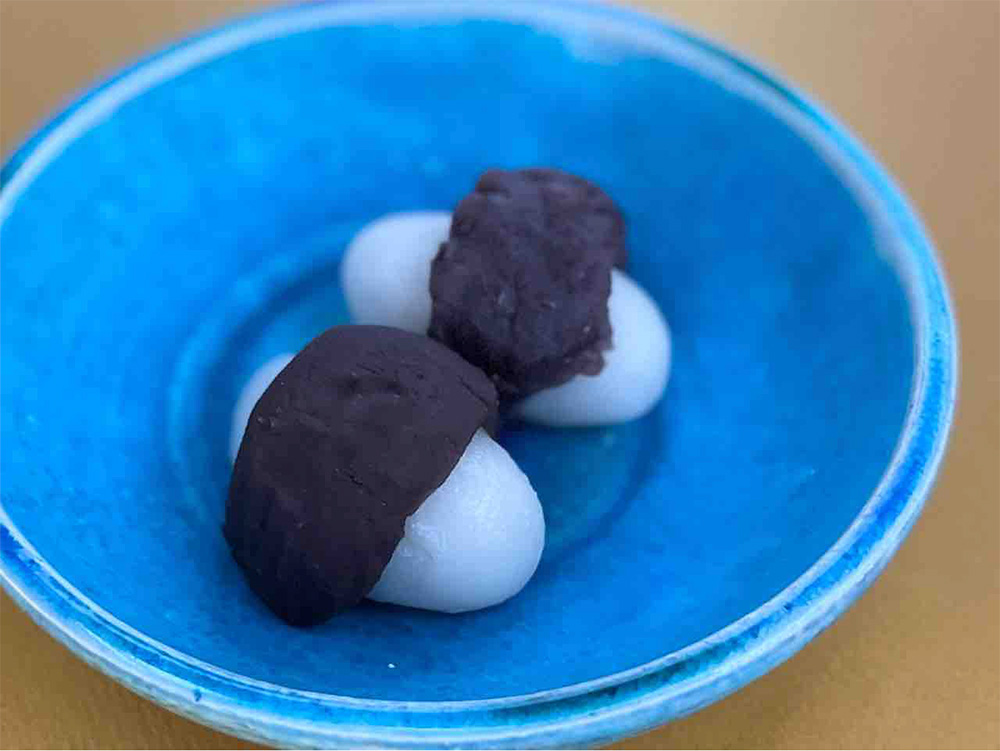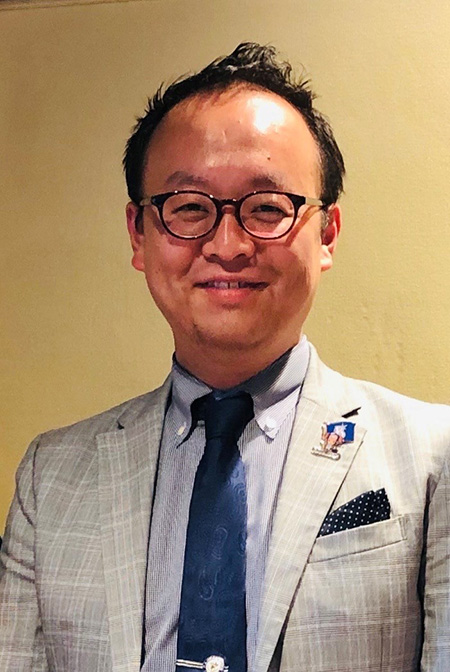World Wide WAGASHI~かわいい和菓子の世界~⑫
京都ならではのお供え餅に思いを寄せて
A Simple Mochi Offering Rich with Kyoto Tradition
鳴海餅本店の「月見団子」 1個173円

今年は9月29日が十五夜ですね。
お彼岸のすぐあとということもあって、いつも以上に忙しくなる和菓子屋さん。
京都の「鳴海餅本店」さんも、お彼岸の「おはぎ」はもちろん、丹波栗を使った「栗赤飯」や「栗餅」も大変評判なので、かなりの量をお作りな上に、今年はお月見も重なって、てんやわんやでいらっしゃいます。
9月に入ると和菓子屋さんて、急激に慌ただしくなるのですよね。
いつもご無理を言って「月見団子」をお作りいただき、東京へ空輸していますが、本当にありがたい限りだと思います次第です。
そんな十五夜のお月見が広まったのは平安時代のことだと言われています。
当時の貴族たちは、月を眺めながら酒を飲んだり、詩歌や管弦を楽しんでいたそうで、そんな月見の宴が庶民に広まるのはだいぶん先のこと。
ただし、宮中での観月宴とはまったく意味合いが異なり、秋の収穫への感謝を込めて、祭礼として執り行われるようになり、またこの時期は、芋の収穫時期にも当たりますため、ススキと共に収穫された芋などをお供えしていたのだそうです。
そんなところから、三方(さんぼう)に乗せて月見団子をお供えするようにもなったのですが、一般的に東京などでは白く丸めた団子を積み上げているだけのシンプルなもので、お供えを終えた後に、いろんな味を加えて食べていたと言われています。
これに対して、名古屋や京都などでは「芋名月」とも呼ばれることから、サトイモの形に似せて作られることが多く、名古屋は三色の団子で、京都では団子に帯を巻くようにしてあんこでくるむスタイルに仕上げられるのです。
真っ白な新粉生地の団子をサトイモのようにやや細長くして、その中腹部分をあんこでくるりと巻くようにして仕上げています。
コシのある団子生地に、こしあん、もしくは粒あんを巻いておりまして、とってもシンプルではあるのですが、そのような意味合いを聞けば、また月見団子ひとつとて奥深いものがありますよね。
※例年、9月1日ごろから10月中旬ごろまでの販売
Narumi-Mochi Honten’s ”Tsukimi-Dango” ¥173
This year, September 29th is the mid-autumn festival Otsukimi or “Moon Viewing.”
Because it’s just after the autumnal equinox, Japanese sweet shops are busier than usual.
Kyoto’s Narumi-Mochi Honten is also very popular for their autumnal equinox “Ohagi,” “Kuri Sekihan” and “Kuri Mochi” made using tambaguri chestnuts, so they will be especially busy this year making quite a large amount for the moon viewing. I’m so grateful that they always go out of their way to make “Otsukimi Dango” for me and have them sent to Tokyo by plane.
It’s said that moon viewing at the mid-autumn festival became popular during the Heian Period. Aristocrats at that time enjoyed drinking alcohol, reciting poetry and listening to musical performances while looking up at the moon, but it was not until much later that the custom spread to the common people.
However, the meaning of this festival was completely different from the moon-viewing banquet held by the imperial court. This was a festival to express gratitude for the autumn harvest. Since this is also the season for harvesting taro, which was harvested along with pampas grass, taro was also apparently given as an offering.
From then on, people began placing dango offerings on sanbo stands, which are like small altars, though in Tokyo and elsewhere, white dango would be piled up and when the offering was finished, it seems that various flavors would be added to the dango before eating them.
On the other hand, in places like Nagoya and Kyoto, dango are made to resemble the shape of taro; in Nagoya dango come in three colors, while in Kyoto they are wrapped in red adzuki bean paste like an obi.
These dango are made from pure white fresh rice flour mochi that is shaped like a taro, with the middle part wrapped in bean paste.
With chewy mochi wrapped in smooth red bean paste, this sweet is so simple, but hearing the meaning behind it, you can really get a sense of something profound about each Tsukimi Dango.
※Available each year from September 1st to mid-October.
鳴海餅本店
https://www.narumi-mochi.jp/
ADDRESS/京都府京都市上京区下立売通堀川西入西橋詰町283番地
TEL/075-841-3080 OPEN HOUR/8:30〜17:00 CLOSE/不定

はた・ちから/47都道府県1000軒以上の和菓子店を実際に訪れ、10000種類以上の和菓子を食べてきた、髙島屋全店の和菓子担当バイヤー。2003年、髙島屋入社、2006年から和菓子売り場担当、2009年から和菓子担当バイヤーに就任。全国各地の和菓子のために奔走する日々。銘菓百選
また、リアルな和菓子情報を、InstagramやTwitterで発信中。著書に『ニッポン全国和菓子の食べある記』(誠文堂新光社)。
As WAGASHI buyer for all of Takashimaya’s stores, Chikara Hata has personally visited over a thousand WAGASHI shops in all of Japan’s 47 prefectures, and has sampled more than 10,000 kinds of WAGASHI. Hata shares information about authentic WAGASHI on Instagram and Twitter.
